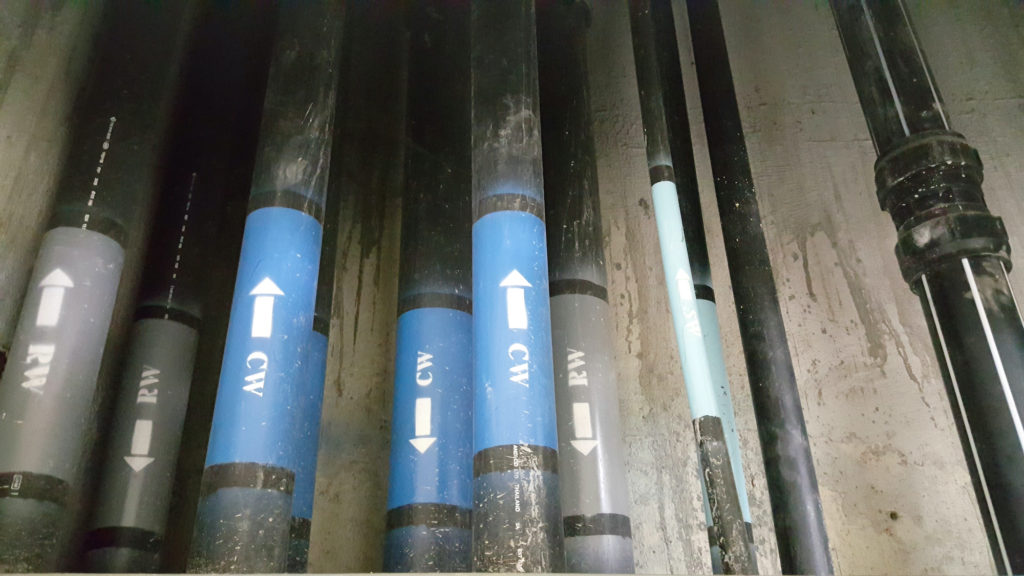
DIY Pipe Replacement:
More Hassle (and Cost) Than It’s Worth
Though it’s often feared, pipe replacement is an inevitable scenario for multi-family communities. Whether your building’s piping system has reached the end of its useful life or there are faulty materials causing failures around the property, there’s simply no way to ignore leaks. And while it may be tempting to tackle a pipe replacement project on your own to save on budget, DIY pipe replacement can actually lead to higher costs and even bigger headaches over time.
Here are a few things to consider, including safety, health, efficiency, and even marketing, when weighing conducting your pipe replacement in house or in stages.

 1. Fire safety
1. Fire safety
When riser (vertical) pipes that pass between floors in a multi-story building are removed, so is some of the firestopping material designed to keep fire from spreading from floor to floor. To maintain code compliance and safety, the annular space between the new pipe and the core drilled hole must be re-firestopped when the new pipes are installed. This is a crucial step to the safety of residents, but could be missed by non-specialists and unlicensed workers.
2. Hazardous materials
If your building was constructed prior to 1978, it’s likely full of hazardous materials like lead paint and asbestos; when the walls are cut, dangerous particles can be released, exposing the installers as well as building occupants. Often, workers may simply be bagging that material and putting it out on the curb. Using a licensed professional will ensure proper HAZMAT removal and disposal protocols are followed.
3. Experience for spotting other issues
Cutting into walls inevitably means encountering other issues, such as mold or bad wiring. A pipe replacement specialist such as SageWater often can spot these problems and alert the property manager, whereas a traditional plumber or in-house maintenance crew may not. They also can spot faulty firestopping. We make plans and include allowances in our bids for such issues to be remedied during the course of the project.
4. Partial replacement
Some properties may replace the main piping system lines but not the lateral lines because it costs less. However, if you have a professional replace the main risers, they will be unable to warranty the connections to the lateral lines, since those are older materials which will likely fail soon, putting you at risk for larger financial burdens in the event of a defect.
5. Mismatched materials
Inexperienced installers may not know about compatibility issues with different piping materials. For example, galvanic and stray current corrosion can occur very quickly when steel pipe is connected directly to copper pipe without a dielectric union. A licensed installer can ensure the proper materials are connected correctly, avoiding these types of mismatched material issues.
6. Mismatched work
In the case of co-ops or condos, bylaws may dictate that residents are responsible for the pipes within the walls of their individual unit. But relying on each resident to be responsible for their own pipe replacement is an invitation for problems. Will their contractor pull a permit? Will they use a licensed contractor? Are they using the same materials with the same warranty? Will they fire-stop correctly and put walls back properly?
A company specializing in repiping will guarantee their work—400 homeowners cannot. SageWater also goes the extra mile when hiring its employees, with background checks, drug-testing, etc., knowing that our teams will be in people’s homes.
7. Insurance woes
Tackling pipe replacement piecemeal, particularly as leakage issues arise, can mean multiple claims to your insurance company, leading to higher premiums and deductibles, as well as possible cancellation.
8. Costs are only going up
Spreading out the building’s pipe replacement over several years means dealing with inevitable price increases as material and labor costs rise. Getting the job done all at once, especially with low interest rates, means getting the lowest prices available and ending up with a brand new, predictable system instead of a patchwork of repairs with different shelf lives.
 9. Resident disruptions
9. Resident disruptions
Pipe replacement means turning off the water every day. But with a full pipe replacement with a professional, it’s one and done. Piecemeal replacement and individual unit replacement also requires shutting off the water—but with those inconveniences spread out at random times, requiring constant notifications and disruptions to residents.
10. Reputation concerns
Shutting down the water and creating noise every time you replace pipe in a different area of the building can lead to a reputation that will scare away new residents. The longer pipe problems persist, and the slower a community is to repair them, the more that community developes a reputation for their plumbing problems. By solving the issue all at once, reputational risks are minimized and, in fact reversed, as the community earns a reputation for being proactive about solving their problems.
11. Duration of repair
A professional team like SageWater is contracted for both fee and schedule, helping to ensure your residents are back to normal when they expect to be. Published schedules, guaranteed delivery dates, and delay fees are all tools used to help manage the performance of an outside vendor that unfortunately cannot be applied in the same way to hold internal staff accountable.
It’s never easy facing the large investment required for a project like pipe replacement. But you’ll find that it’s much easier—and more economical in the long run—to complete the work in full and with repipe professionals who know how to manage the process, guarantee their work, and ease the burden on residents.
Ready to learn more? Read about SageWater’s Repipe process.


